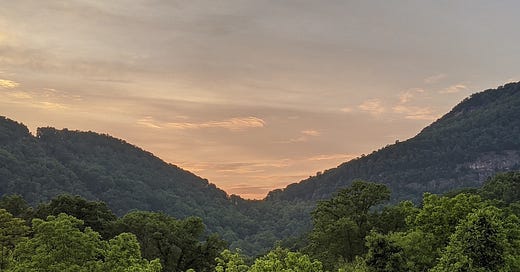Daniel Boone wasn't the first person to cross the Cumberland Gap. Indians had long been traversing this saddle between peaks in the Appalachian mountains separating Virginia from Kentucky. They in turn were following deer, bison and other game animals.
Yet it was Boone's account of the crossing that made the Cumberland Gap known to the American public. He described to his biographer John Filson the mountain barrier that divided the waters flowing east to the Atlantic from those flowing west to the Ohio, the Mississippi and the Gulf of Mexico. “These mountains are in the wilderness, as we pass from the old settlements in Virginia to Kentucke, are ranged in a S. west and N. east direction, are of a great length and breadth, and not far distant from each other,” Boone said. “Over these, nature hath formed passes that are less difficult than might be expected from a view of such huge piles. The aspect of these cliffs is so wild and horrid that it is impossible to behold them without terror. The spectator is apt to imagine that nature had formerly suffered some violent convulsion, and that these are the dismembered remains of the dreadful shock, the ruins, not of Persepolis or Palmyra, but of the world!” This final dramatic flourish was Filson's rather than Boone's. The mountains here are challenging but not terrifying.
Boone and a few others were on a hunting trip. Kentucky was more than they had dreamed of. “We found everywhere abundance of wild beasts of all sorts,” said Boone. "The buffaloes were more frequent than I have seen cattle in the settlements, browzing on the leaves of the cane or cropping the herbage on those extensive plains, fearless, because ignorant, of the violence of man. Sometimes we saw hundreds in a drove, and the numbers about the salt springs were amazing." Woodland complemented the open reaches. “In this forest, the habitation of beasts of every kind natural to America, we practised hunting with great success.”
Boone later returned to Kentucky with his family and other settlers. The Indians there had tolerated occasional hunters, but permanent residents were a different matter. For decades Kentucky was a battleground between the indigenous tribes and the invaders.
Not all of the latter came through the Cumberland Gap. Some crossed the mountains farther north and floated down the Ohio River. They came haphazardly and in organized expeditions. Wealthy men like George Washington invested in land companies that acquired huge tracts which were then surveyed and sold to individuals and families. Sometimes the acquisitions were dignified with treaties with the Indians. Sometimes they were not.
Boone was a hunter. He was a farmer. And he was an entrepreneur. He understood that easing access to Kentucky from Virginia would facilitate the growth of settlements west of the mountains, raising land prices. In the pay of the Transylvania Land Company, Boone widened the path through the Cumberland Gap into what came to be called the Wilderness Road. Thousands took the road into Kentucky, eventually producing a population so numerous as to require the establishment of a state government for Kentucky, previously the western part of Virginia.
Even after other routes to Kentucky and the west diminished the importance of the Cumberland Gap, that passage through the mountains lived on in American memory. In the 1890s historian Frederick Jackson Turner proposed a theory of American history highlighting the importance of the frontier. The frontier, said Turner, was where democracy recurrently reinvented itself, as settlers established their own versions of the institutions they had known in the east. “Stand at Cumberland Gap,” wrote Turner, appealing to the mind's eye of his readers. “Watch the procession of civilization, marching single file—the buffalo following the trail to the salt springs, the Indian, the fur-trader and hunter, the cattle-raiser, the pioneer farmer—and the frontier has passed by.”
After the frontier passed, the Cumberland Gap declined to the status of historical curiosity. Railroads found different passages through the mountains. Interstate highways blasted their own cuts. Passengers in airplanes fly over the gap without knowing it’s there. This part of the Wilderness Road has reverted to wilderness.
The Cumberland Gap was a portal from America's east to its west. This made it a gateway from America's past to its future. That future is in now the past, and the gap is as quiet as before Daniel Boone arrived.




The timing of this post is perfect. 2025 marks the bicentennial of the Erie Canal. Organizations from the NY state level on down to ports along the path are celebrating this achievement, which opened up a flood of people and commerce between the East and Inner America. Your post reminds us that the Cumberland Gap was the precursor to Clinton's Ditch. Both had their day and should be staples in the study of America's growth.
The Cumberland Gap played prominently in John Fox Jr.'s "Little Shepherd of Kingdom Come". It was must-reading for my family from the earliest 20th century. Generations of parents would read it to their children. My brother Chad was named after the protagonist, Chadwick Buford. Whenever I hear of the Cumberland Gap, I cannot help but think of Chadwick Buford, the little shepherd of Kingdom Come.